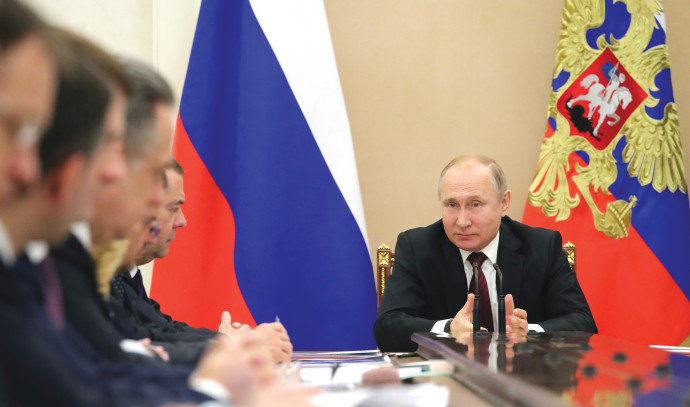Russian economic statistics are a collection of lies and distortions. They are meant to convince people at home that their economy is chugging along despite the war, and people abroad that Western economic sanctions don’t work and therefore should be rescinded. Many international economists, including official organizations, have bought into this type of Russian propaganda.
When strict sanctions were imposed on Russia at the start of its invasion of Ukraine, the Russian economy was expected to plunge by some 10-15% during 2022. That didn’t happen: based on official data Russia’s real, or inflation-adjusted GDP declined by only 2.2%. Russia actually performed better in wartime and under Western sanctions than during the pandemic year 2020, when its economy shrank by 2.6%.
This gave President Vladimir Putin ammunition to tout Russia’s economic achievements. Speaking to the Russian Union of Industrialists and Entrepreneurs, and more recently at the cabinet of ministers meeting, he claimed that the economy had shrugged off the sanctions, the playing field had been cleared of foreign competitors, and domestic companies could now successfully expand.
International economists have been equally optimistic. Last fall, the International Monetary Fund expected Russia’s economy to contract by another 2.3% in 2023; it now predicts 0.3% growth followed by an even faster 2.1% expansion in 2024. This, too, compares favorably to prewar years: prior to the pandemic, the Russian economy grew by only around 1% a year, on average.
Other international organizations, such as the World Bank and the OECD (Organization for Economic Cooperation and Development), are less upbeat but have also adjusted their expectations upward.
All these better-than-expected results and even rosier scenarios are based on official data from the Russian government. However, since the start of the invasion, many Russian statistics are no longer publicly available and the ones that are can’t be trusted. On the contrary, it is safe to assume that a government that lies about everything else, lies about its economy as well.
During the Cold War, the CIA concluded, using Soviet statistics, that the Soviet Union had the world’s second-largest economy whose size and production capabilities rivaled those of the United States. But when communism collapsed, Russia’s economy turned out to be not much larger than Portugal’s.
Statistics in contemporary Russia are equally deceptive. While the government says that it has rerouted all of its oil exports and much of its natural gas from Europe to Asia, this doesn’t take into account the vast discounts at which it now sells its resources.
As many as a million young people have left Russia since the start of the war, and half a million others have been sent to fight the war. Just these two factors could not help but inflict severe damage on the Russian economy, giving the lie to official economic statistics.
In a recent article in Fortune, prominent Yale University economists Jeffrey Sonnenfeld, Stephen S. Roach and Steven Tian dissected how the IMF forecast parroted Putin’s deceptions about the state of the Russian economy.
Look at Russia’s inflation statistics
BUT THE best way to see how Russia falsifies its economic data is in its inflation statistics. Officially, inflation peaked last April at around 18% and came down in 2022. It stood at 11% in February 2023. This is not much worse than before the start of the war, when inflation measured around 9%.
The official figure is impossible to confirm or refute, but common sense and indirect evidence suggest that actual inflation is running substantially higher.
Russia’s industry and consumer markets are heavily dependent on imports of goods and components. Before the war, Russian imports came predominantly from the West. Since the imposition of Western sanctions, it has had to obtain imports either in the gray market or by finding new suppliers in non-Western countries.
Busting sanctions involves risk of secondary sanctions, for which Russia’s partners want to be compensated. Circuitous delivery routes also involve additional costs. Finally, since the number of potential sources of supply has been reduced, the law of economics suggests that the price charged by remaining suppliers inevitably goes up.
As a result, even though officially Russia’s imports fell by only around 12% during 2022, their physical quantities declined by a far larger margin. Meanwhile, domestic supply has been reduced by the departure of hundreds of foreign companies. Local production also declined since it relies on foreign components.
The supply shock in the Russian market was exacerbated on the demand side by government purchases of food and clothing. Additionally, Bloomberg has found that the incomes of Russia’s poorest households were boosted by payments to soldiers fighting in Ukraine and their families. As many employees were drafted or fled the draft abroad, labor shortages developed forcing employers to offer higher wages.
Finally, the corruption premium that has always been high in Russia inevitably went up because of wartime uncertainty. Taken together, all this suggests that Russia’s consumer prices rose much faster in reality than in official statistics – or at least by 30%. It is actually a conservative estimate.
According to Romir, an independent research group, inflation in the staples category, the so-called fast-moving consumer goods, measured 48% last year. Ingredients for borscht, another measure of prices of staples in Russia, rocketed by 56%.
Meanwhile, inflation in the Baltic states and Poland measured close to 20% and in Hungary around 25% in 2022. It is unlikely that Russia, which was fighting a war and straining under strict sanctions, could have achieved a lower rate of inflation.
The level of inflation directly impacts other economic data. Since GDP growth is measured in inflation-adjusted terms, an adjustment for higher actual inflation points to a much deeper economic recession last year and more of the same in 2023.
Despite the IMF forecast, the only growth Russia will see this year will be in its lies and propaganda as it tries to convince the public at home and abroad that it has successfully overcome Western sanctions.
The writer is an independent economist whose clients include The Economist Intelligence Unit. He’s a member of the board of the US Andrei Sakharov Foundation, which was recently named by the Russian government “an undesirable foreign entity.” From 2014-21, he wrote a weekly column for the Kyiv Post. His articles on the war in Ukraine are based in part on his volunteer work on the Polish-Ukrainian border.




